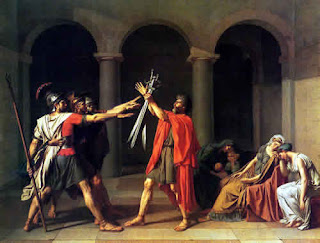Tuesday, November 18, 2008
Final Reflection.
1. Use of color
2. Use of composition
3. Your ability to create the illusion of different surfaces and textures
4. Your ability to create the illusion of space and depth.
Be sure to use specific examples from your paintings in your description.
This is it!
To do:
1. Make sure paintings are finished.
2. Write final reflection on your blog.
3. Use the end of term checklist to make sure you've done all the posts on your blog.
4. Clean materials and take them home or arrange for their storage.
5. Clean off you shelf.
6. Make sure any still lives you've built are cleaned up and the objects are put away.
On friday we will have a major clean-up.
Monday, November 10, 2008
this is week 11.
Monday, November 3, 2008
Observations on the History of Oil Painting.
Use your research from this term and concepts and terms we’ve discussed in class to make some general observations about the history of oil painting.
Use these questions to guide your writing:
Who have been the major players throughout the history of oil painting? Why is this so?
Who seems to be missing from the history of oil painting? Why is this so?
Where in the world did most oil painting taking place?
Where did all these oil paintings go? Why? How does where these paintings “live” affect who learns about them and why?
How has subject matter changed over time? Why?
This is week 10.
Tuesday, October 28, 2008
Why oil paint?
Do a little research on the history of oil paint.
Where does it come from? What is it made of? When was it invented?
With all the choices of materials out there for artmaking, especially in this day and age, why do artists still turn to oil paint? What does oil paint do that other materials don’t do?
Monday, October 27, 2008
This is week 9.
Wednesday, October 22, 2008
What is a portrait?
Within this folder there are two more folders, one labeled paintings and one labeled Not Paintings.
Please look through them both.
In a post on your blog address the following questions/issues.
Remember to use vocabulary/concepts we’ve discussed in class and to use specific examples from the paintings to back up your ideas.
What is a portrait?
Choose three portraits, paste them into your post (include the artists’ names) and describe how the artist uses color, composition, and subject matter (objects, setting, clothing, etc.) to communicate something about the person whose portrait they’ve made OTHER than what the person looks like.
How do the artists you’ve chosen address the concept of portrait? How do they work within the tradition of portrait-making OR how do they reinvent the concept of a portrait?
Monday, October 20, 2008
This is week 8.
This is a short week due to Parent-Teacher conferences on Thursday and Friday.
Our goal for the week is to get the Surface and Texture paintings as close to finished as possible so we can start something new after your long weekend.
Be sure to have an 18"x24" canvas ready to go before the end of the day Wednesday.
Over the long weekend you should spend some time updating your blog. This might just mean doing the most recent homework assignment. It might also mean looking at the feedback you got earlier in the week and catching up. Good luck. Email me with any concerns.
Saturday, October 18, 2008
A Sense of Place homework update.
Sunday, October 12, 2008
A Sense of Place.
- Paste them into a post on your blog. Be sure to include the artists' names.
- Describe the moods of the two paintings.
- Describe HOW the artists created the moods using specific examples from the paintings and the vocabulary we've developed so far this term.
This is week 7.
Tuesday, October 7, 2008
Where are you at?
This is week 6.
Monday, September 29, 2008
SOME famous paintings.




Sunday, September 28, 2008
This is week 5.
Monday, September 22, 2008
Creating the illusion of surface and texture

This is week 4.
Tuesday, September 16, 2008
White Objects Thumbnail Sketches
Monday, September 15, 2008
Using composition as a tool
This is week 3.
Also, make sure your blog is up-to-date by checking the blog roll hanging next to the bulletin board in the studio and in the BLOG BLOG BLOG folder on First Class. It's time to get into the routine of posting homework and works-in-progress to your blog by Friday and commenting on two of your classmates' blogs by Monday.
Sunday, September 14, 2008
Studies in Smallness: finished paintings
Wednesday, September 10, 2008
Studies in smallness: my set-ups
Wednesday, September 3, 2008
Morandi vs. Van Gogh: Color
Describe the differences between the artists' choices of color palette and subject matter in these particular paintings.
Also, how does the choice of color palette influence or affect the subject matter?

Still Life, 1955, Giorgio Morandi

Still Life, 1955, Giorgio Morandi

Irises, 1890, Vincent Van Gogh

Sunflowers, 1888, Vincent Van Gogh


























